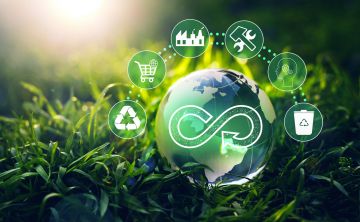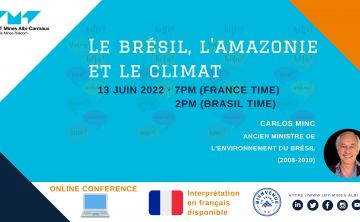Knowledge of materials, a decisive expertise for the future of the circular economy
An interview with Professor Didier Perrin, research professor at IMT Mines Alès and head of the Durability & Recycling of Polymers and Composites research topic within the Polymers Composites Hybrids (UPR PCH) team at IMT Mines AlèsMaterials Research Center (C2MA).
Didier Perrin works on the issue of mixes of polymers and composites resulting from electric and electronic waste, end-of-life vehicles, and the marine and aeronautical industries. He is also actively involved in developing channels for recycling materials in partnership with companies, producer responsibility organizations, competitiveness clusters and schools/universities. He won the 1st Place FIEEC Carnot Applied Research Award in 2021 for his research project "Mélanie" with corporate partners ST and Suez. The circular economy and the topic of materials are taught in the new Specialized Master's PRINEC, Processes and Resources for Circular Economy Engineering in collaboration, a program jointly offered by IMT Mines Albi and IMT Mines Alès , with support from the Valdelia producer responsibility organization.
How can better knowledge of materials make the circular economy more efficient?
Because someone who is knowledgeable about a material will be able to give it a new life and recover a high-quality secondary material. When we talk about recycling, we need to take a material's durability into consideration. This is a real constraint, given the fact that each type of material has an inherent durability that can be affected by exogenous factors. For example, unlike glass, plastic materials have a propensity for aging that raises questions about whether it is worthwhile to recycle them. Recycling plastics also depends on factors that are inherent to their properties, particularly their immiscibility, which is responsible for:
- a reduced rate of use of plastic waste in recycling channels
- mechanical problems which affect the purity of waste, the presence of diverse plastic impurities can affect the performance of materials made from recycled plastic.
The figures attest to this complexity: 86% of glass bottles that are "collected" are recycled, while the plastic recycling rate is between 6 and 10% of plastics collected. The rest inevitably falls by the wayside.
What are some solutions to reverse this trend and recycle a maximum of plastic materials?
The key to solving this problem is to make progress in sorting. It must be organized based on comprehensive knowledge of materials and their properties. If we look at the state of plastic recycling today, it's clear that only two types of plastics are recycled: polyethylene terephtalate (PET), used to make bottles for water, and high-density polyethylene (PE-HD) used to make containers for laundry detergent and cleaning products. Recycling plastic materials 'blindly" (i.e., without taking their properties into account) has a deleterious impact on the quality of secondary raw materials produced through recycling. Several aspects are not taken into account:
- the degradation and aging of plastics through photooxidative effects (sun, heat, humidity, immersion) which affect their mechanical properties and miscibility
- problems relating to odor, appearance and microstructure evolution, which impact the recycling process
The end result is that we obtain secondary raw materials produced through recycling that are more expensive than virgin raw materials.
These examples show why expertise in the field of materials is needed to organize circular economy systems. Materials must be better indentified in order to be effectively sorted – and therefore better recycled.
Given all these factors, what has to be done on the international level in terms of potential solutions?
First of all, we need to put a stop to overconsumption and overproduction. Recycling must not be used as a pretext for continuing this vicious cycle. Second, products must be designed in an eco-friendly way based on an end-of-life approach. Only such an approach will allow us to grasp the problems related to the end-of-life phase and rethink a product's design in the upstream phases, to ensure that it fits into a truly circular system.
The collection of end-of-life products must also be better organized. We must collect less, but in a more effective way, to recover higher-quality products. This is important in order to improve the quality of secondary raw materials produced through recycling. To engage consumers to reach this objective, sorting guidelines, which are often confusing, must be simplified and standardized. At the same time, sorting centers can fine-tune their processes, using artificial intelligence, for example.
Another approach would be to adapt a material to its intended purpose and make manufacturers responsible over the lifetime of the product. A bag for carrying groceries does not need to have as long of a lifetime as a bumper for an automobile, so we can imagine two kinds of lifetimes for products:
- Quickly biodegradable products that are biosourced, without adversely affecting food crops: made with micro-organisms that secrete polymerizable fluids (Polyhydroxyalkanoates-PHA, polybutylene succinate-PBS, polybutylene adipate-co-terephtalate-PBAT), these products are compostable at 20°C, instead of 60°C as in industrial composting, so they can be placed in weekly or domestic compost, where they degrade within weeks after their use.
- Products with a long lifetime, based on what I refer to as cycling, meaning the recycling of products would be organized based on function – that is, if possible, a single material assigned for the manufacturing of a single product. In such a scenario, manufacturers would be responsible for the entire lifecycle of their products. If we go back to the example of bumpers, an automaker must consider the entire lifecycle of bumpers, from production to the end-of-life phase, after which they will once again become bumpers. This is an example of material recycling that helps prevent materials from being polluted, ensure the quality of the secondary material and better control its performance. This is beginning to take shape, as can be seen with wind turbines, but it remains a utopian vision.
News
Parole d'experts

An interview with Professor Didier Perrin, research professor at IMT Mines Alès and head of the Durability & Recycling of Polymers and Composites research topic within the Polymers Composites Hybrids (UPR PCH) team at IMT Mines Alès' Materials Research Center (C2MA).




